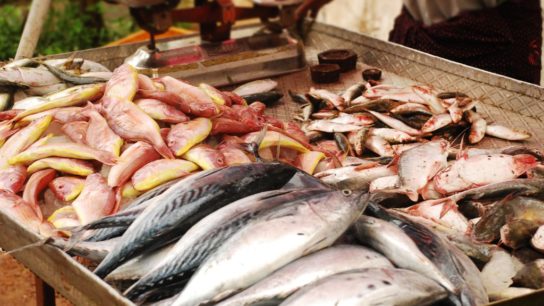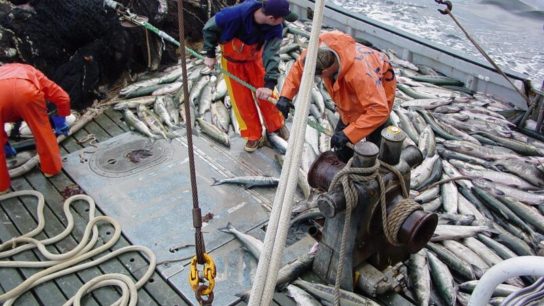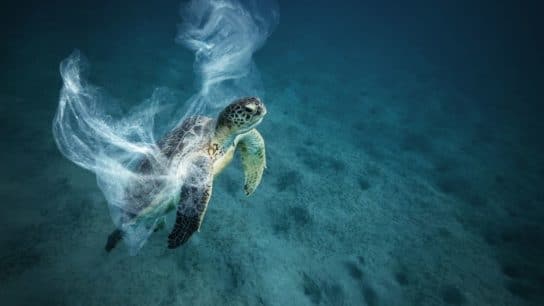In the mid-20th century, the Green Revolution ushered in unprecedented technological advancements in the world’s agricultural systems. But while it was crucial in providing for the world’s growing population, the Green Revolution has necessitated rampant deforestation, biodiversity loss and was predicated upon a drastic increase in greenhouse gas emissions from agriculture. New economic models of production and extraction are needed to limit the degenerative human impact on our terrestrial ecosystems, and to fully take advantage of the resources and ecological services available to us. To accomplish both these targets and more, the burgeoning blue economy may be the next page in humanity’s story of sustainable development.
—
The blue economy involves all economic activity related to oceans and coastal ecosystems. In a fully realised blue economy, these areas act as the primary mechanism for extraction and production of resources and economic growth. The blue economy emphasises protecting and sustainably developing oceans, and implementing policies that ensure better stewardship of marine ecosystems, wildlife and resources. The blue economy can be considered a component to the larger green economy, which focuses on an efficient and equitable use of resources and emphasises sustainable development without degrading the environment.
The blue economy encompasses a number of diverse sectors, including food production, tourism, energy, transportation and waste management. The current global economic output of blue economy activities is valued at around USD$1.5 trillion.
The blue economy includes several fast-growing industries, benefitting from the high ceiling for innovation most of these sectors still have. For instance, a 2018 report by the Food and Agriculture Organization found that aquaculture, the organised farming of fish, crustaceans, algae and other marine organisms, was the fastest growing food production sector, and would continue to be so over the coming years, providing 60% of fish available for human consumption by 2030. Around 350 million jobs worldwide are tied to fisheries and other ocean or coastal economic activities.
You might also like: Kenya Emerges as a Leader in Managing Plastic Pollution
The potential benefits of developing the blue economy are enormous. Blue economies offer the possibilities of improved efficiency in our land and ocean management, better treatment and governance of marine ecosystems, a more equitable model of global health standards, lower emissions and resilience against climate change. If governments can transition even a part of their economic focus from land-based extraction and production, blue economies may well be the future of sustainable development.
Prioritising a blue economy means investing in relevant infrastructure, technologies, research and development, job creation and education. At the moment, this is a difficult proposal considering how invested we are in terrestrial economic activities, especially agriculture. While global agriculture accounts only for 3% of global GDP, it can contribute to over 25% of domestic GDP in many developing countries. 38% of global land surface is used for agriculture, of which 26% is used for livestock production. Each year, around 50 billion chickens, 1.5 billion pigs, 545 million sheep, 444 million goats and 300 million cattle are slaughtered for meat. The Green Revolution has created a gargantuan global terrestrial agricultural industry, and replacing it even partially with a blue economy will be a demanding and potentially disruptive task.
Aquaculture and Growing Food Demand
By mid-century, the planet will need to supply food for two billion more people than today, up to a total 11 billion people by 2100. As Global South countries develop, diets will change as incomes rise and demand for meat products increases. This is a problem, since terrestrial agriculture, land-use change, deforestation and livestock production are together the second-highest contributing sector to global GHG emissions. To alleviate the stressors that population growth and food demand place on land-based agriculture, alternatives need to be sourced that can allow equitable growth while limiting environmental damage.
As a critical component of the blue economy concept, aquaculture allows us to tap into the vast and insofar relatively untouched farmable potential of oceans. Aquaculture is a broad term, including freshwater, inland and coastal farms. Disappointingly, freshwater aquaculture can often be nearly as environmentally harmful as conventional agriculture, and can negatively affect marine ecosystems, organisms and human communities.
Waste from aquaculture farms can deplete water’s oxygen level, causing algae blooms and dead zones. Concerns have also been raised over the introduction and potential escape of non-native marine species, which could disrupt local ecosystems and food chains.
In response to these concerns, the emerging sub-practice of open-ocean mariculture may be able to mitigate the adverse effects of aquaculture. Mariculture refers to offshore aquaculture that takes place in open oceans. Open-ocean mariculture provides several distinct environmental benefits over conventional freshwater or coastal aquaculture.
The map below shows the average net primary productivity of the world’s oceans, or the concentration of microscopic organisms and other primary producers like phytoplankton. The green, yellow and red zones indicate oceans with high concentrations of primary producers, and therefore more complex and diverse food webs and ecosystems. These areas are mostly concentrated around landmasses, while the darker blue areas indicate open oceans that are comparatively devoid of nutrients, organic matter and life. Open-ocean aquaculture poses a much reduced threat to environmental degradation precisely because mariculture farms are located kilometres away from the closest major marine ecosystem.
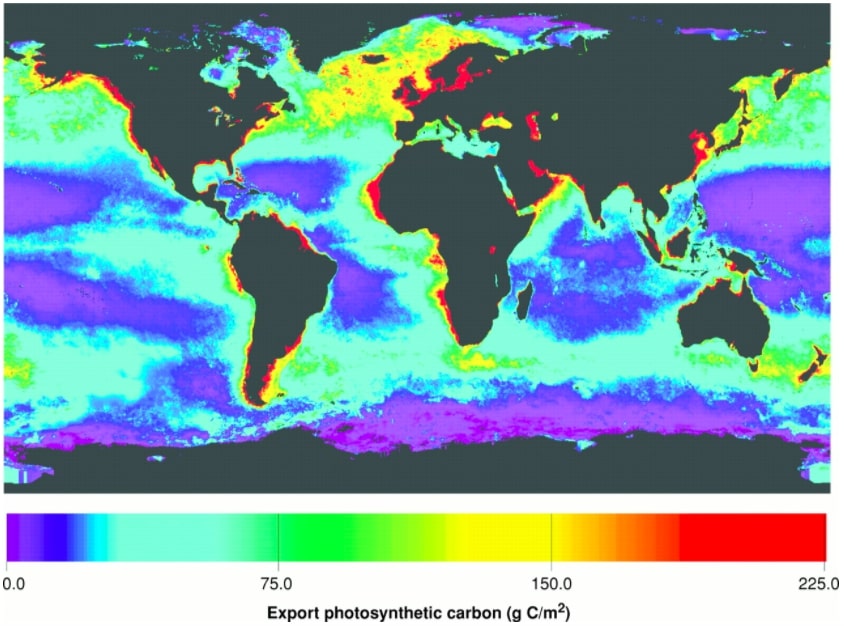
Figure 1: Annual mean export production for the world oceans; Science; 1998.
Some concerns persist over open-ocean aquaculture. Even in parts of the ocean that are relatively lifeless, organic and inorganic waste matter can sink to the ocean floor and disrupt the smaller ecosystems located in abyssal plains. Currents also tend to be stronger in the open ocean, potentially dispersing waste matter throughout the global ocean if farms are not managed correctly. Mariculture producers have also been observed to utilise worrying amounts of antibiotics in open-ocean farms.
Advocates of mariculture believe that these challenges, while pressing, are manageable, and that open-ocean mariculture is ideally suited to solving these problems. More space allows fish cages to be larger, and producers can thereby reduce overcrowding, one of the main contributors to waste pollution from fisheries. Data regarding the impact of non-native species escaping their enclosures is also inconclusive at best. When thousands of Atlantic salmon escaped from a fishery in the Pacific in 2017, most observers did not believe that they would cause significant food chain disruption, and in fact were unlikely to survive in the wild since they had become accustomed to eating prepared food pellets.
The real draw of focusing on fisheries and aquaculture, however, is the undeniable benefit a sea-based food production industry would have over conventional land-based agriculture.
Aquaculture requires less intensive resource and energy input when compared to terrestrial farms, as fish are much more efficient at converting their feed into meat edible for humans. Because fish are cold-blooded and don’t need to fight gravity, they have small and undemanding skeletal and muscular structures, which require less energy than those of their terrestrial counterparts, and therefore less feed. A single beef cattle requires 10 pounds of cereal to provide a pound of edible meat, while a single salmon requires just 1.3 pounds of vegetable and protein feed to produce the same amount.
Other marine animals can be even more efficient. As filter feeders, molluscs such as clams and scallops do not need to be provided with feed, as they feed off of the organic matter around them. Shellfish farming can therefore provide what is essentially a zero-cost food conversion ratio when farmed for human consumption, and can even be employed as a means of scrubbing water pollutants and fighting eutrophication.
The conversion efficiency of fish when compared to livestock is the primary reason behind aquaculture’s low carbon footprint, which the FAO estimated to be around 0.45% of global emissions, significantly lower than total livestock emissions of 14.5%. Granted, a portion of the discrepancy is due to livestock simply being a much larger industry than aquaculture. However the more efficient conversion rate of fish means that aquaculture has a lower emissions rate per capita than most livestock. Additionally, fish do not require freshwater to stay alive. Back on land, agriculture irrigation accounts for 70% of global freshwater use.
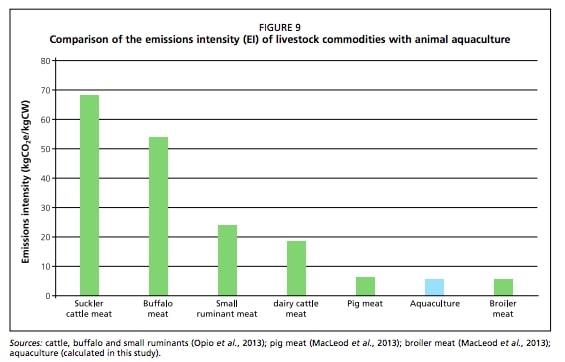
Figure 2: Emissions intensity of various livestock commodities and aquaculture; FAO; 2019.
Concerns over space use are also largely unfounded. A 2017 study by the University of California found that if fish farms were moved offshore, a farm covering an area of 0.025% the ocean’s surface could satisfy global food demand and allow wild stocks to recover. All these factors combined contribute to a reduced individual carbon footprint when fish become the primary source of protein in diets. A 2014 study in the UK found that individuals who followed a pescatarian diet had half the carbon footprint of a diet heavy in meat.
The benefits of an economy focused on fish as the main source of protein in diets do not stop at emission reductions and more efficient land use, as supplanting a primarily carnivorous diet with pescatarian habits can carry significant health benefits. A 2019 study in Denmark found that replacing red meat with fish in Danish people’s diets could prevent around 170 deaths from coronary heart disease annually, and add an aggregate 7 000 healthy years of life per year. The study also concluded that the health risks of eating red meat increased with age, and that men were especially susceptible to health complications as a result of meat consumption.
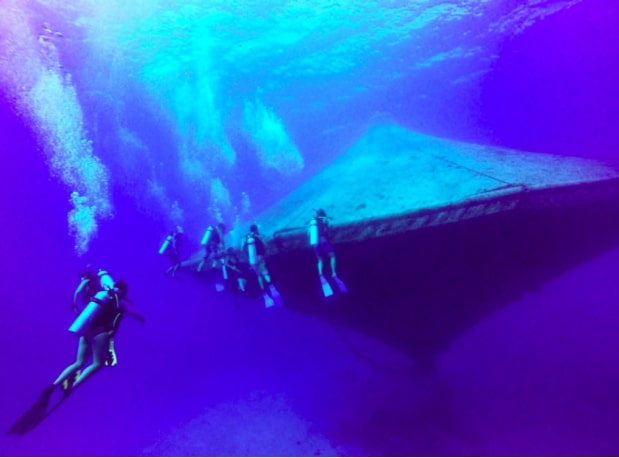
Image 3: Divers inspecting an open-ocean mariculture farm at the Cape Eleuthera Institute in the Bahamas.
A Blue Economy to Fight Climate Change
The oceans are vital natural systems that support livelihoods and provide sustenance worldwide. 80% of all life on Earth lives in the ocean. 3.5 billion people depend on oceans as their primary source of food. Alongside soil and plants, oceans serve as one of the planet’s major systems for carbon sequestration and storage. But despite the world ocean’s importance to human development and maintaining our current standards of living, we have only barely scratched the surface of the services oceans can provide.
A blue economy would be able to tap into the mammoth carbon sequestration potential of the world ocean, which can absorb up to one third of annual anthropogenic CO2 emissions. This sequestration potential is mostly due to the unique ecosystems that form around coastlines. Vegetated ocean habitats, including mangrove forests, peat bogs, salt marshes and seagrasses, cover less than 1% of seabeds, and yet may account for over 70% of all carbon storage in ocean sediment.
Termed “blue carbon,” the CO2 absorbed by oceans and coastal ecosystems outnumbers stored carbon in virtually any other ecosystem on Earth. Seagrasses and marine vegetation in coastal ecosystems comprise only 0.05% of plant biomass, but have the capacity to store an equal amount of carbon per year as all terrestrial biomass. Since waterlogged coastal soils are largely devoid of oxygen, vegetation that stores carbon tends to decay at a much slower rate than in other ecosystems, allowing carbon to remain sequestered for longer.
Other marine ecosystems provide even more direct services to coastal communities. Marine natural infrastructure, such as barrier reefs, mangrove forests and wetlands protect against environmental impacts such as hurricanes, storms and inundations. These structures reduce coastal erosion, purify water and substantively minimise soil salinisation and coastline damages. A healthy coral reef, for instance, can absorb up to 97% of a wave’s energy during a storm.
Oceans are also growing in popularity as sites for renewable energy generation. As the global demand for alternative energy sources rises, coastal and offshore marine environments provide the ideal location for wind, wave and tidal energy infrastructure. Offshore wind in particular is one of the fastest growing energy sectors in the world. The International Energy Association has estimated that the offshore wind market grew by 30% between 2010 and 2018, and expects it to become a $1 trillion industry by 2040. Led by the EU, the UK and China, the scope and potential of offshore wind power is incredibly exciting, as it has the potential to generate more than 18 times our current global annual energy demand. Like many blue economy sectors, offshore wind is a nascent industry and technology, which is benefiting from a relentless influx of innovation and investor confidence.
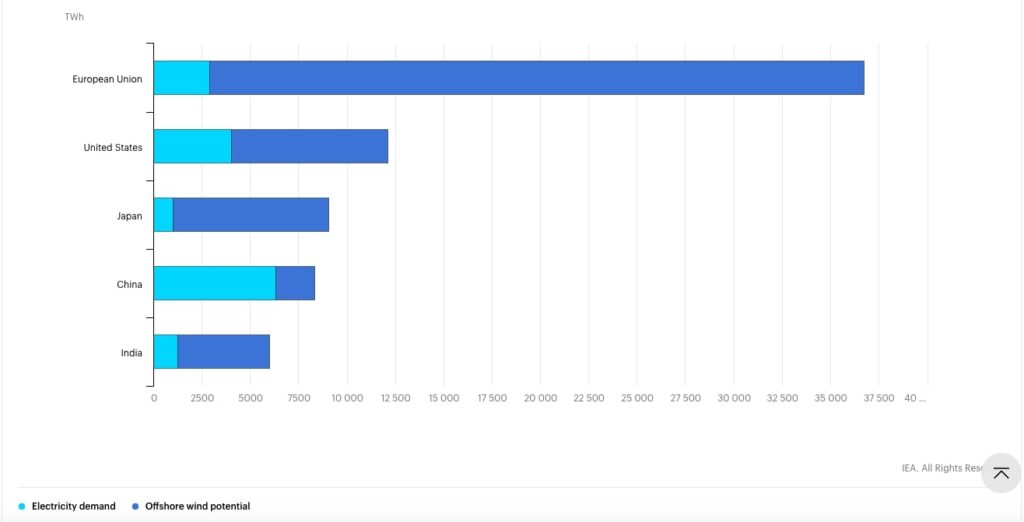
Figure 4: Offshore wind electricity demand and technical potential in 2018; International Energy Association; 2019.
A blue economy would be able to tap into the vast potential of oceans and coastal ecosystems to mitigate climate change and protect communities from its impacts. Creating an economic system that values the natural productivity of oceans is essential so that we can not only benefit from them, but are also equipped with the economic tools and justification to protect them. Current economic trends are rapidly degrading ocean environments through pollution, altering of marine and coastal habitats, climate change and unsustainable and unregulated extraction of marine resources. By promoting the concept of blue economies worldwide, governments can acknowledge the value of their oceans and coastlines and integrate these assessments into their economic policy planning.
The Blue Economy and Equity
In addition to its economic benefits, governments also need to be made aware of the welfare benefits that can emerge from investing in the blue economy. Oceans and marine resources are the essential pillars upon which economies and cultures of many developing countries are built, particularly small island developing states (SIDS) and least developed countries (LDCs).
A 2017 report on the potential of blue economies co-authored by the World Bank and the UN discusses how blue economies could function to assist SIDS and LDCs in meeting the UN’s Sustainable Development Goals. A blue economy essentially allows many low-income countries to tap into their most valuable resource, their oceans, armed with the modern technology and economic plans needed to optimise resource use.
As described in the report, the blue economy concept “seeks to promote economic growth, social inclusion, and preservation or improvement of livelihoods while at the same time ensuring environmental sustainability.” This framework grants SIDS and coastal LDCs the opportunity to pursue low-carbon and resource-efficient strategies of development that maximise efficiency and minimise environmental harm. Such a framework creates jobs, enhances livelihoods, improves food security and reduces inequality by involving marginalised groups possessing important traditional knowledge and skills including women, young people and indigenous communities.
Climate change is certain to impact lower income countries most severely, with coastal nations being the most exposed and vulnerable. While a blue economy can be applicable on a global scale, the most important outcomes would be for SIDS and LDCs, as it is better equipped to address the unequal distribution of climate change damages and costs. A blue economy can focus on improving resilience for coastal communities by strengthening natural infrastructure and preserving ecological services. Doing so can also boost critical revenue streams from industries such as maritime shipping and coastal tourism.
The importance of preserving ocean environments is not lost on coastal nations. In 2018, the Seychelles pursued a debt-for-nature swap, a financial mechanism wherein a portion of its foreign debt was forgiven in exchange for investments into local biodiversity conservation initiatives. The Seychelles is setting aside 410 000km² of their ocean for conservation and sustainable development purposes. The government also pursued the world’s first ‘blue bond’ with the collaboration of the World Bank and the Global Environment Facility, worth $15 million. An island country whose economy relies almost exclusively on fishing and tourism, the Seychelles’ initiatives are expected to support its blue economy ambitions and support sustainable development while improving resilience against climate change.
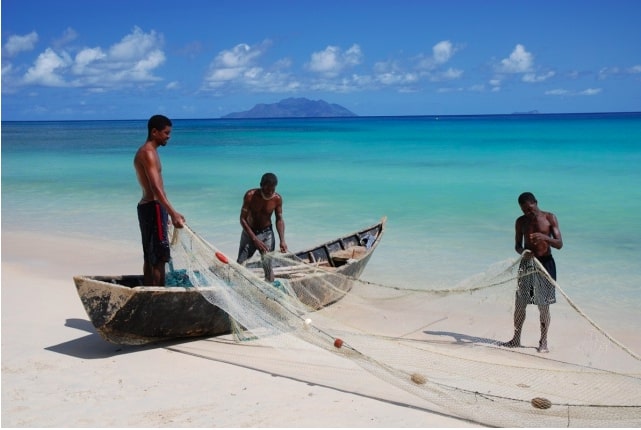
Image 5: Fishermen in the Seychelles. Fishing remains one of the primary economic sectors in the island country.
Sustainable aquaculture, offshore energy generation and blue carbon sequestration in SIDS and LDCs can attract private investments and foreign interests to support transitions towards a blue economy. Innovative financial mechanisms, such as debt-for-nature swaps, blended financing that specifically targets developmental action and blue bonds can help establish blue economies where they are needed most. In the long term, blue economies in developing nations can even lead to improved self-sufficiency in these areas, reducing dependence on foreign actors.
Nascent blue economy sectors offer substantial promise for potential innovation, and despite relatively low industry expertise, investors have exhibited substantial interest and excitement towards the growth prospects of the blue economy. Lenders and financiers know that this industry is set to experience tremendous growth in the coming years, and many consider the blue economy transition an ideal place to ride the wave of the larger global transition towards clean energy, sustainable resource extraction and efficient food production.
Investors are also waking up to the promise of extremely profitable bioprospecting and marine biotechnology. Bioprospecting is the systematic search and extraction of organisms from seabeds and other ocean environments, taking advantage of the high genetic diversity of marine life for innovative biotechnological applications in medicine, environmental remediation and biofuels. Bioprospecting is currently a poorly regulated industry, and left to its own devices can be harmful to seabed ecosystems by removing keystone species or overexploiting resources. However, bioprospecting can be extremely beneficial to societal needs, if it is done sustainably and is properly regulated through a formal economic framework.
The most exciting aspect of the blue economy is that it is still in its infancy. Industries that have become a staple of our economy, such as agriculture or fossil fuels, have been around for so long that innovation has hit a ceiling; there is little else to be done to improve their efficiency or sustainability. It is one of the reasons as to why market forces have been slowly pushing out fossil fuels, despite staunch industry resistance. There is simply little room left for growth in these industries.
The blue economy is different. There has been a historical lack of investment for innovation towards its sectors with regards to financial and human capital, and we are just now beginning to understand the true extent to which oceans protect us and provide critical ecological services. A pivot from governments and firms to focus on innovation and expansion of the blue economy could bring about a productive boom akin to that of the Green Revolution. If done sustainably and with equity in mind, a ‘Blue Revolution’ of sorts could provide a clear pathway towards a more sustainable and resilient future.
Featured image by: Flickr










